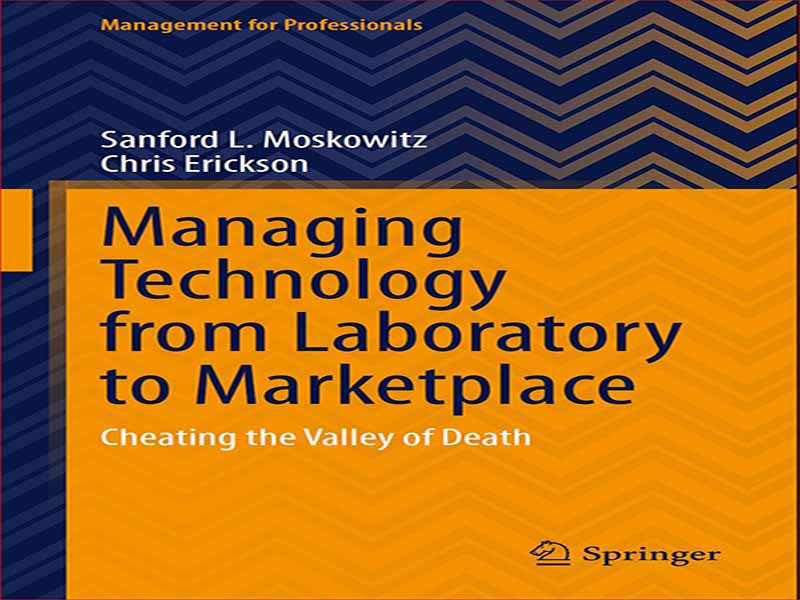- عنوان کتاب: Managing Technology from Laboratory to Marketplace
- نویسنده: Sanford L. Moskowitz
- حوزه: مدیریت فناوری
- سال انتشار: 2024
- تعداد صفحه: 206
- زبان اصلی: انگلیسی
- نوع فایل: pdf
- حجم فایل: 5.08 مگابایت
چشم انداز فناوری در طول سه دهه گذشته بسیار تغییر کرده است. آنچه به عنوان فناوری اطلاعات (IT) شناخته می شود در واقع به چیزی بسیار متفاوت تبدیل شده است. دهه های 1980 و 1990 شاهد ظهور رایانه شخصی به عنوان ویژگی اصلی دنیای فناوری پیشرفته بود. در حالی که رایانهها بخش مهمی از انقلاب صنعتی چهارم (4IR) هستند، اکنون تنها یکی از جنبههای داستان فناوری پیشرفته امروزی هستند. فناوری اکنون در حال گسترش فراتر از دنیای نسبتاً مسطح و دو بعدی محاسبات دیجیتالی است که در آن ماشینها – هرچند بسیار پیچیده – به سادگی دستورالعملهای برنامههایی را دنبال میکنند که در آنها تغذیه میشود. در قرن بیست و یکم، خود دنیای سه بعدی در حال دیجیتالی شدن است. محصولات، اجزا و سیستمهایی که چند دهه پیش به سختی وجود داشتند – الگوریتمهای عصبی، ریزحسگرها، دستگاههای هوشمند، انرژی پاک – اکنون با فناوری پیشرفته رایانههای شخصی مرتبط میشوند تا سیستمهایی ایجاد کنند که میتوانند جهان اطراف ما را درک، دیجیتالی کنند و به آن واکنش نشان دهند. ارتباط نزدیک با این تصور جدید در فناوری، توانایی آن در حل مسائل روزمره و در نهایت تفکر مستقل است. فن آوری قرن بیست و یکم با ترکیب قدرت ادراک جدید خود با سطح بالاتری از خودمختاری، نه تنها کاری را که انسان ها از آن می خواهند سریعتر انجام می دهد، بلکه قادر خواهد بود راه های جدید و غیرقابل تصوری را برای مقابله با مبرم ترین مشکلات جهان نشان دهد. از جمله تغییرات آب و هوایی، انتقال انرژی، کمبود مواد غذایی، مراقبت های بهداشتی و بیماری، کاهش بهره وری و انبوهی از مشکلات به ظاهر لاینحل دیگر دوران مدرن. کسانی که هنوز بر این باورند که فناوری اطلاعات در قرن بیست و یکم «نی است که نوشیدنی را به هم می زند»، به طور جدی به اشتباه درک کرده اند که این دوره کنونی چیست. حل مشکلات دشواری که در سن 4IR با ما مواجه است، به سرعت توجه را از محصولات دیجیتال پایین دستی مبتنی بر فناوری رایانه ای که در دهه های 1980 و 1990 تسلط داشتند، به سمت نوع جدیدی از دنیای فناوری که اکنون توسط مواد پیشرفته و دستگاه ها، اجزا و قطعات کنترل می شود، سوق داده است. سیستم هایی که مستقیماً از آنها ساخته شده اند. حسگرها، رباتیک، داده های بزرگ، تولید و ذخیره انرژی، مهندسی ژنتیک، کنترل آب و هوا، فناوری خودمختار، همه به طور فزاینده ای به کشف، توسعه و تجاری سازی مواد کاملاً جدید بستگی دارند. پیشرفت مواد در آینده، رشد اقتصادی و رقابت ملی به توانایی شرکتهای بزرگ و کوچک، ایجاد و تزریق نسل جدیدی از نانومواد، آلیاژهای پیشرفته، پلیمرهای پیچیده، بیوتراشههای تشخیصی، مدارهای کوانتومی، ابررساناها، مواد هوشمند، کریستالهای مایع بستگی دارد. و فناوری های بالادستی مشابه.
The technological landscape has changed a great deal over the past three decades. What has been known as information technology (IT) has in fact evolved into something very different. The 1980s and 1990s saw the rise of the personal computer as the central feature of the world of high tech. While computers remain an important part of the so-called Fourth Industrial Revolution (4IR), they are now only one aspect of the story of high tech today. Technology is now expanding beyond the rather flat, two-dimensional world of digital computing where machines – albeit very sophisticated ones at that – simply follow the instructions of programs fed into them. In the twenty-first century, the three-dimensional world itself is becoming digitalized. Products, components and systems that hardly existed a few decades ago – neural algorithms, microsensors, smart devices, clean energy – now link up with advanced personal computer technology to create systems that can perceive, digitalize and react to the world around us. Closely associated with this new perceptibility in technology is its ability to solve daily problems and ultimately to think independently. Combining its new powers of perception with its higher level of autonomy, twenty-first-century technology will not just do what humans ask it to do ever faster but will be enabled to point out new and previously unimaginable ways to tackle the world’s most pressing problems including climate change, energy transition, food shortage, health care and disease, productivity decline and a host of other seemingly intractable problems of the modern era.
Those who still believe that IT “is the straw that stirs the drink” in the twenty-first century have seriously misread what this current era is all about. Solving the difficult problems that confront us in the age of 4IR is rapidly shifting attention from those downstream digital products based on computer technology that dominated the 1980s and 1990s, toward a new type of technological world controlled now by advanced materials and the devices, components and systems made directly from them. Sensors, robotics, big data, energy generation and storage, genetic engineering, climate control, autonomous technology all depend increasingly on the discovery, development and commercialization of radically new materials. Future material progress, economic growth and national competitiveness hinge on the ability of firms large and small, creating and injecting into the economy a new generation of nanomaterials, advanced alloys, complex polymers, diagnostic biochips, quantum circuits, superconductors, smart materials, liquid crystals and similar upstream technologies.
این کتاب را میتوانید از لینک زیر بصورت رایگان دانلود کنید:
Download: Managing Technology from Laboratory to Marketplace




































نظرات کاربران